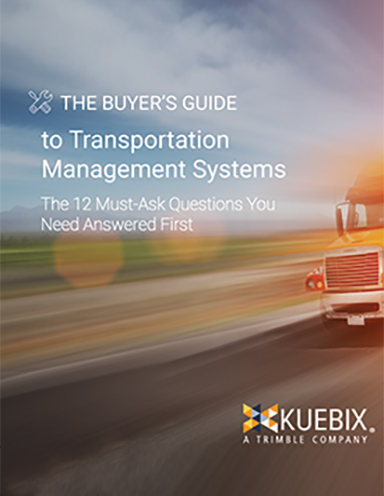Earth Day 2019: 6 Ways to “Go Green” By Leveraging Supply Chain Technology

The first Earth Day was in 1970 - since then our population has doubled, we’re emitting 2.4 times more CO2, sea levels have risen 4 inches, but the “Go Green” world has also changed for the better.
“Go Green”
Sustainability initiatives and efforts to “go green” are trending through every industry and many are focusing on the supply chain.
There are innumerable reasons why companies are prioritizing sustainability.
These reasons range from everything from worries about climate change, the need to save money and streamline operations, to increasingly eco-friendly customer bases and the need to please investors that are prioritizing sustainability.
Bloomberg New Energy Finance reported in January that global venture capital investment into startups focused on sustainability jumped 127% to $9.2 billion in 2018, which is the highest seen since 2010.
If that increase in investments doesn’t show where the economy is headed, Forbes recently reported on a study which found that:
- 68% of Millennials bought a product with a social or environmental benefit in the past 12 months.
- 87% of consumers will have a more positive image of a company that supports social or environmental issues.
- 88% will be more loyal to a company that supports social or environmental issues.
- 87% would buy a product with a social and environmental benefit if given the opportunity.
- 92% will be more likely to trust a company that supports social or environmental issues.
There is plenty of evidence that sustainability initiatives can improve companies’ bottom lines and strengthen customer loyalty and brand awareness.
Finding the opportunities to implement these green initiatives, however, can be seen as a challenge for many organizations unfamiliar with this new terrain.
For most companies selling physical products either B2B or B2C, the low-hanging fruit for environmental change lies within their supply chains.
The simplest and most effective way for companies to understand, streamline and make strategic changes to their supply chains is to leverage supply chain technology like transportation management systems (TMS).
With the help of technology, companies can make environmentally friendly changes to their supply chains and add to their overall company sustainability initiatives.
Here are 5 ways supply chain technology can help companies can “go green”:
1. Plan Routes More Effectively
According to the American Trucking Associations, 3 billion gallons of fuel was consumed for business purposes in 2016. That number has likely grown as the gross domestic product (GDP) in the United States increased by 2.3% from 2016 – 2017 as reported by the World Bank.
Reducing fuel consumption should be a priority for businesses not only to benefit the environment but also to reduce transportation costs.
Technology can help logistics professionals choose the best route for every load, something that can be nearly impossible to do by hand. Instead of manually comparing routes and consolidating loads one by one, routers and warehouse employees can leverage optimization technology to automatically create the perfect load based on predetermined parameters. An algorithm in the technology will ensure the fewest number of miles are driven for the maximum number of orders per truck, reducing overall fuel consumption.
2. Select the Best Mode
Selecting the best mode for every shipment is another way to ensure less fuel (and money) is used on a shipment. Many shippers don’t have time to compare LTL, FTL, ground freight pricing, and parcel for every order, however. With a transportation management system in place, every available mode type can be easily compared on a single screen. That means orders which would normally be shipped as LTL, for example, may be able to be shipped as parcel. By choosing the best mode type for every shipment, companies reduce wasted space on trucks and save money in the process.
3. Fill Empty Miles
For companies with their own fleet assets, filling empty backhaul and deadhead miles can be a lofty goal. Finding and booking available backhaul freight can be nearly impossible to do manually. It can require one or more individuals to dedicate all of their time to find opportunities, and more often than not those opportunities aren’t repeatable. By connecting to a transportation management system with a large shipping community like Kuebix, fleet owners can be easily matched with available backhaul freight. This means that trucks drive empty less of the time and less fuel goes to waste.
Download the eBook Putting Community in TMS: Enabling the Network Effect in Transportation Management
4. Waste Less Fuel Idling in the Yard
Idling is a large culprit of wasted fuel consumption. According to the U.S. Department of Energy, a typical long-haul truck “idles about 1,800 hours per year, using about 1,500 gallons of diesel.” That’s a shocking amount and most certainly cutting into companies bottom-lines, not to mention contributing to overall fuel emissions. While much of this time idling comes from regulated rest periods, some of it comes from long waits at gates and for available docks in yards. Not only are detention fees being racked up, but fuel usage is also as well.
Companies who want to reduce idling time in their yards can leverage supply chain technology like yard management systems (YMS) to streamline operations. Features like gate check, dock scheduling, and hostler optimization can speed up operations in the yard and get drivers in and out quickly.
5. Embrace the Circular Supply Chain
The circular supply chain is about taking apparent waste materials and returned goods and turning them into products which can be resold. Shippers can embrace this level of “reduce, reuse, recycle” by using a transportation management system to help track their orders and returns. Complete visibility to products down to the SKU level can help OS&D and customer service departments understand exactly where returns or damaged products are and turn apparent trash into revenue streams.
6. Reduce the Paper Trail
At their core, supply chain technologies are helping move traditionally operating supply chains to the digital age. That means saying goodbye to the physical paper-trail associated with shipping and instead of keeping track of all operations online. By leveraging cloud-based supply chain technology, companies save paper while also speeding up their operations.
Should My Company “Go Green?”
If you’re asking yourself if your company should try to improve their environmental footprint with a sustainability initiative, the simple answer is yes. No matter why you decide to “go green” there will likely be positive benefits for your company. You’re likely to save money, please customers and investors and make a positive impact on the environment.
A large portion of companies’ carbon footprints stems from the supply chain, making it the obvious place for many companies to begin their green initiatives. With the help of supply chain technology like transportation and yard management systems, the overall environmental impact can be reduced in a smart and simple way.
Related Article: Circular Supply Chain – The Missing Link
Related eBook
Putting Community in TMS: Enabling the Network Effect in Transportation Management New!
In this eBook, Adrian Gonzalez, President, Adelante SCM in partnership with Kuebix TMS, describes how transportation management systems are transitioning from being “inside the four walls” applications to becoming operating systems that power transportation communities and enable network effects. Download Now!
More Resources from Kuebix TMS
Article Topics
Kuebix News & Resources
Visibility + TMS = A Winning Combination Trimble Placed in 2021 Gartner Magic Quadrant for Real-Time Transportation Visibility Platforms Kuebix Positioned Again as a Challenger in 2021 Gartner Magic Quadrant for TMS The Buyer’s Guide to Transportation Management Systems TMS Update: Adoption accelerates The Logistics of Valentine’s Day during COVID-19 Pandemic Research: Trends in the Supply Chain and Their Impact on the Transportation Management System Market More KuebixLatest in Transportation
Baltimore Bridge Collapse: Impact on Freight Navigating Amazon Logistics’ Growth Shakes Up Shipping Industry in 2023 Nissan Channels Tesla With Its Latest Manufacturing Process Why are Diesel Prices Climbing Back Over $4 a Gallon? Luxury Car Brands in Limbo After Chinese Company Violates Labor Laws The Three Biggest Challenges Facing Shippers and Carriers in 2024 Supply Chain Stability Index: “Tremendous Improvement” in 2023 More Transportation













